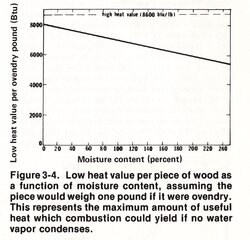nojo said:
I ask this becuase most of the wood stove burners I know insist that their wood is fine, but it clearly hisses and puts out a lot of smoke, which they say is just what the stove does. You know the type that think a 400 stove top temp is way too hot. I had one guy complaining to me the other day that his stove wont heat his house. Its a hearthstone and he said it wont get hot. He also said he's burning oak he cut down last spring. I mentioned that might be the problem and he said what everyone else says that it sat all summer so its good and seasoned. He said sometimes he can get his stove really hot (the thermometer on top says 400) and it still doenst heat well. I mentioned he should aim for about 550-600 and he told me its not good for soapstone stoves to get hotter than 400 because they crack...
I dunno it just kind of bugs me that most people I know with woodstoves (even good EPA stoves) let them smoke all day, think wood seasons in log form over a summer and all that good stuff.
rrrr
Yes, I do think that most wood stove burners do not burn right.
1. Some have absolutely no clue as to proper practices.
2. Naturally, the fuel has be in the equation too. As was stated on this forum by someone, even when folks finally realize that their wood is not as dry as it should be, they are very reluctant to admit it. After all, they bought the best from a well respected wood seller and he told them that it was good seasoned wood. Not until they burn dry wood will they see the light.
3. Most folks don't even know what type of wood they have.
4. Most folks have no idea how to season wood nor do they realize the length of time it requires.
5. A lot of folks (like Jake) use a hydraulic splitter in the horizontal mode rather than vertically
because they are more comfortable splitting from a standing position and do enough sitting at work . . . and they have good, strong backs and utilize proper lifting techniques . . . and are built like Paul Bunyan and  .
.
6. The practices of controlling the stove: I read too often about folks who can't get their stoves hot enough....even with the draft fully opened! No wonder the stove won't get hot because too much heat is going up the chimney. There can be many other examples.
7. Poor installs; dirty chimneys, etc.
A good example is that fellow who can't seem to get his stove to 400 degrees and thinks that is really hot. Well, it is hot to touch, but not hot for a wood heating stove. And what about that soapstone cracking? I think the only way it would crack would be by hitting it too hard with a log or some other object or by heating it up too fast, especially after setting cold all summer. Otherwise that soapstone can take a tremendously high temperature.




